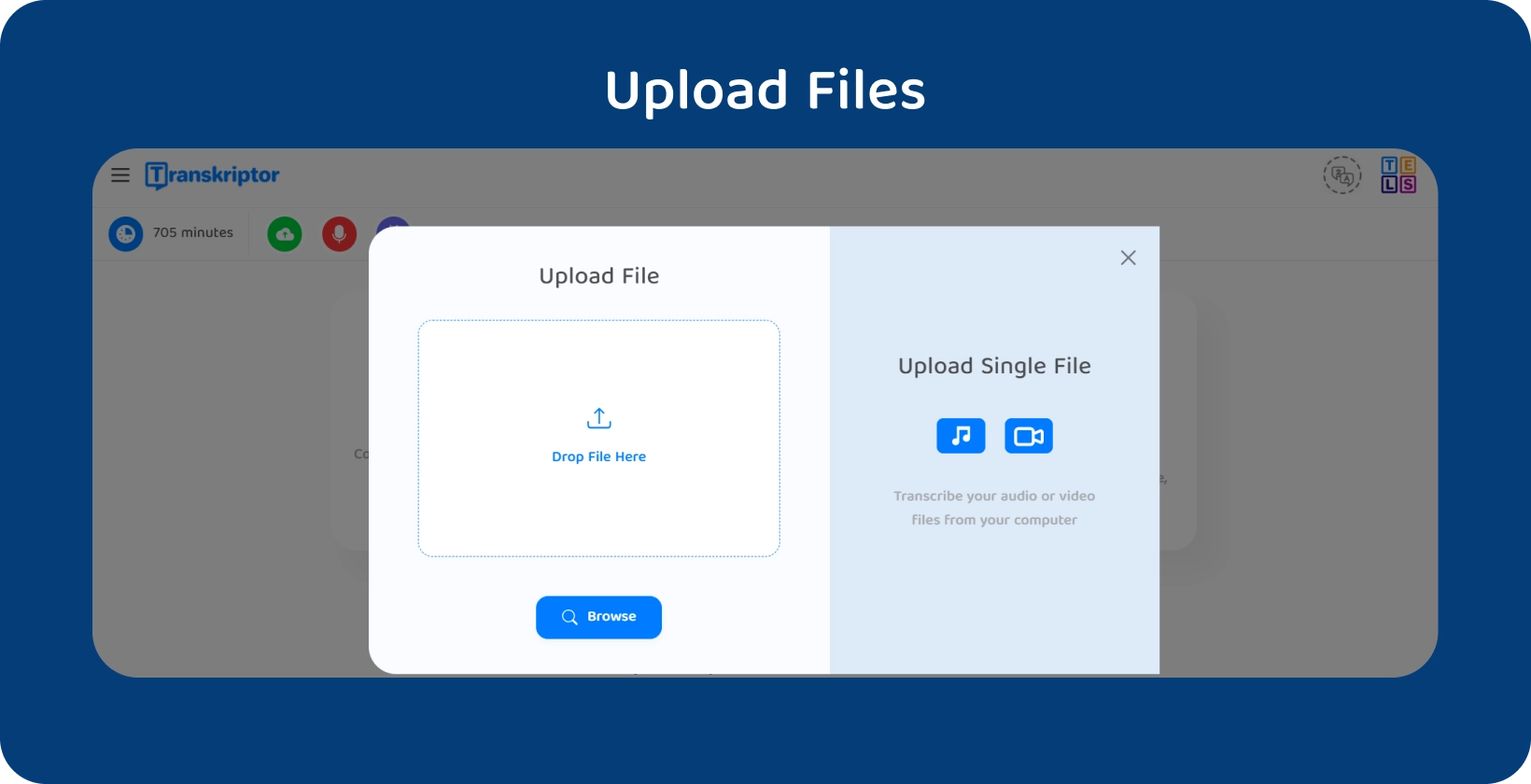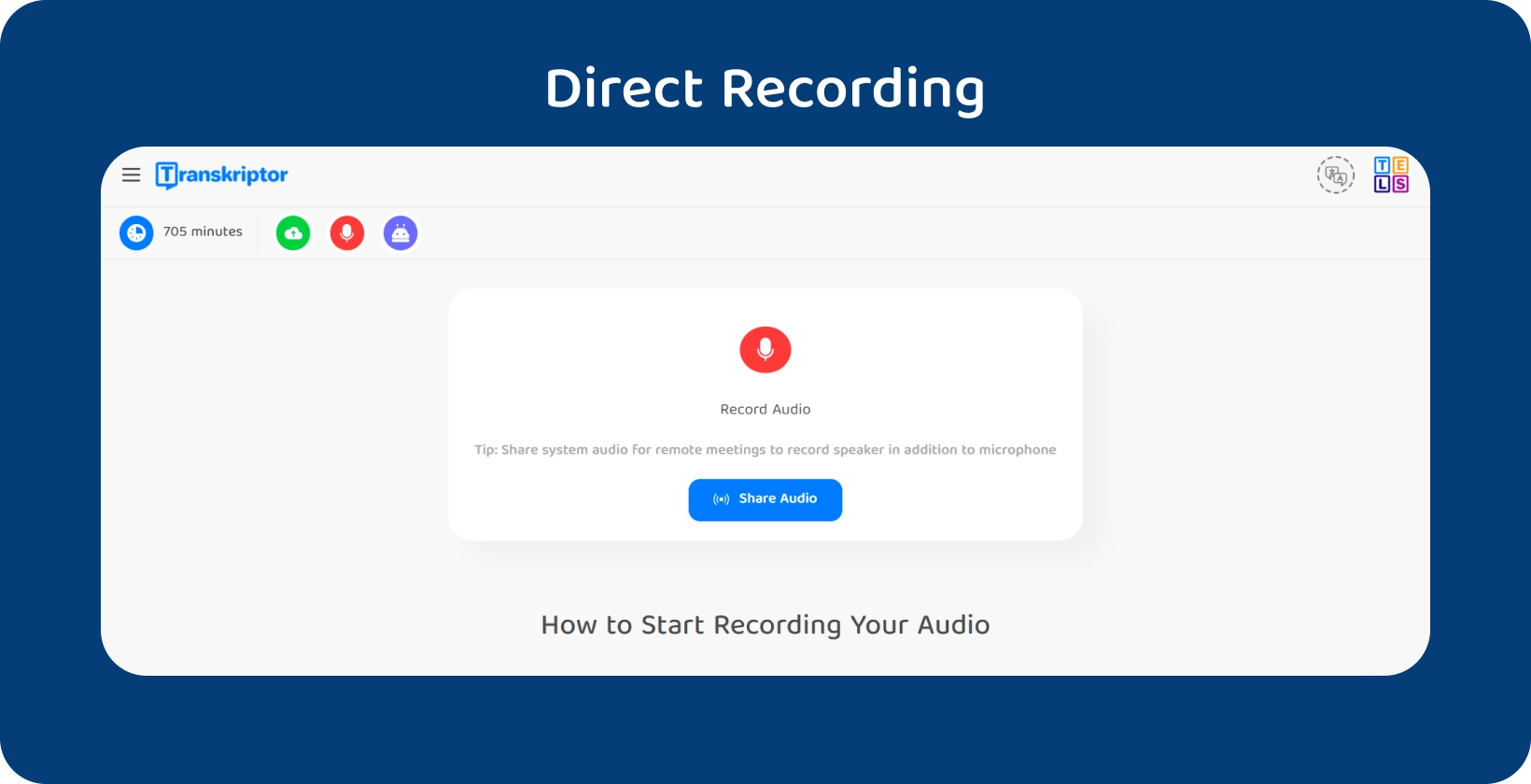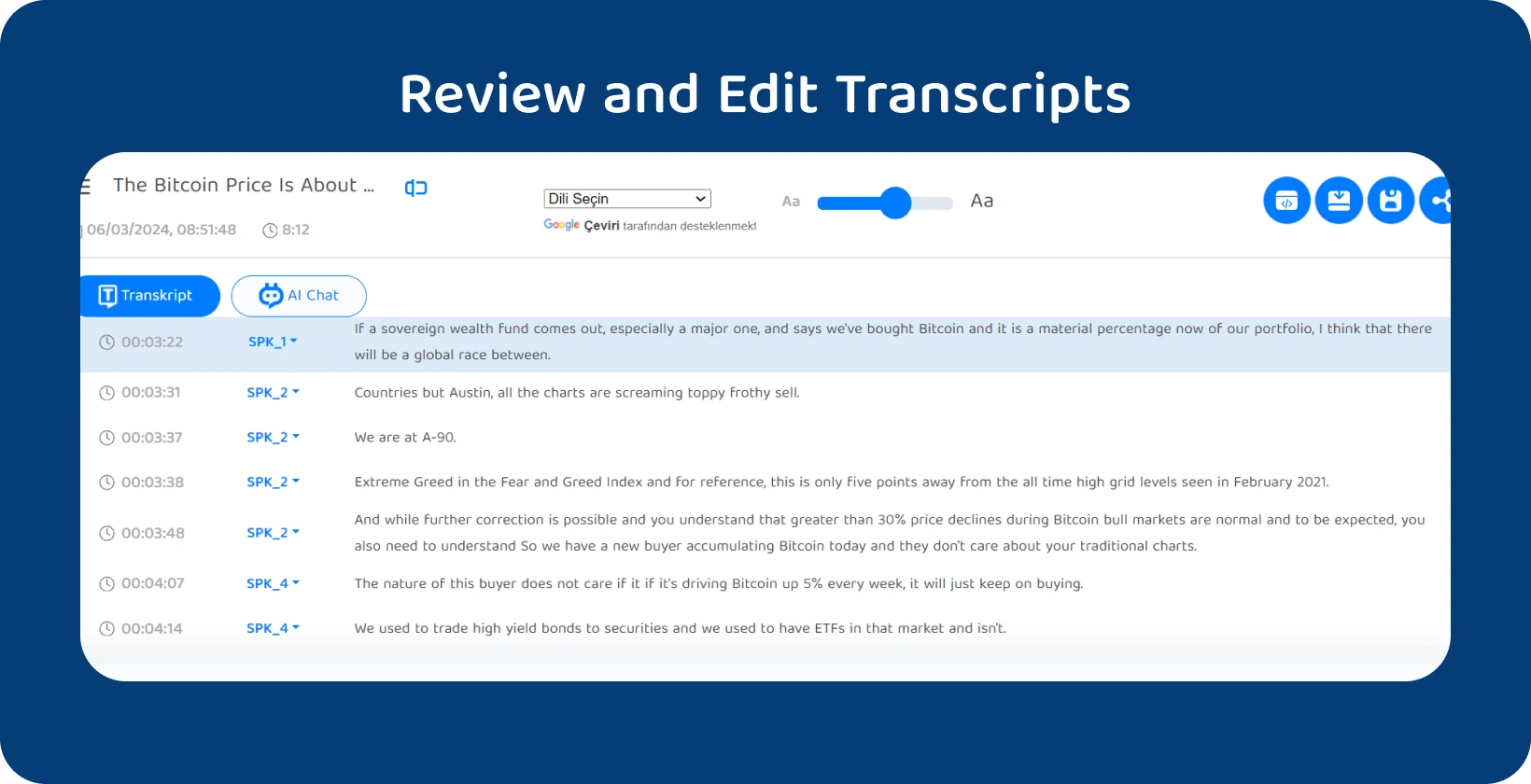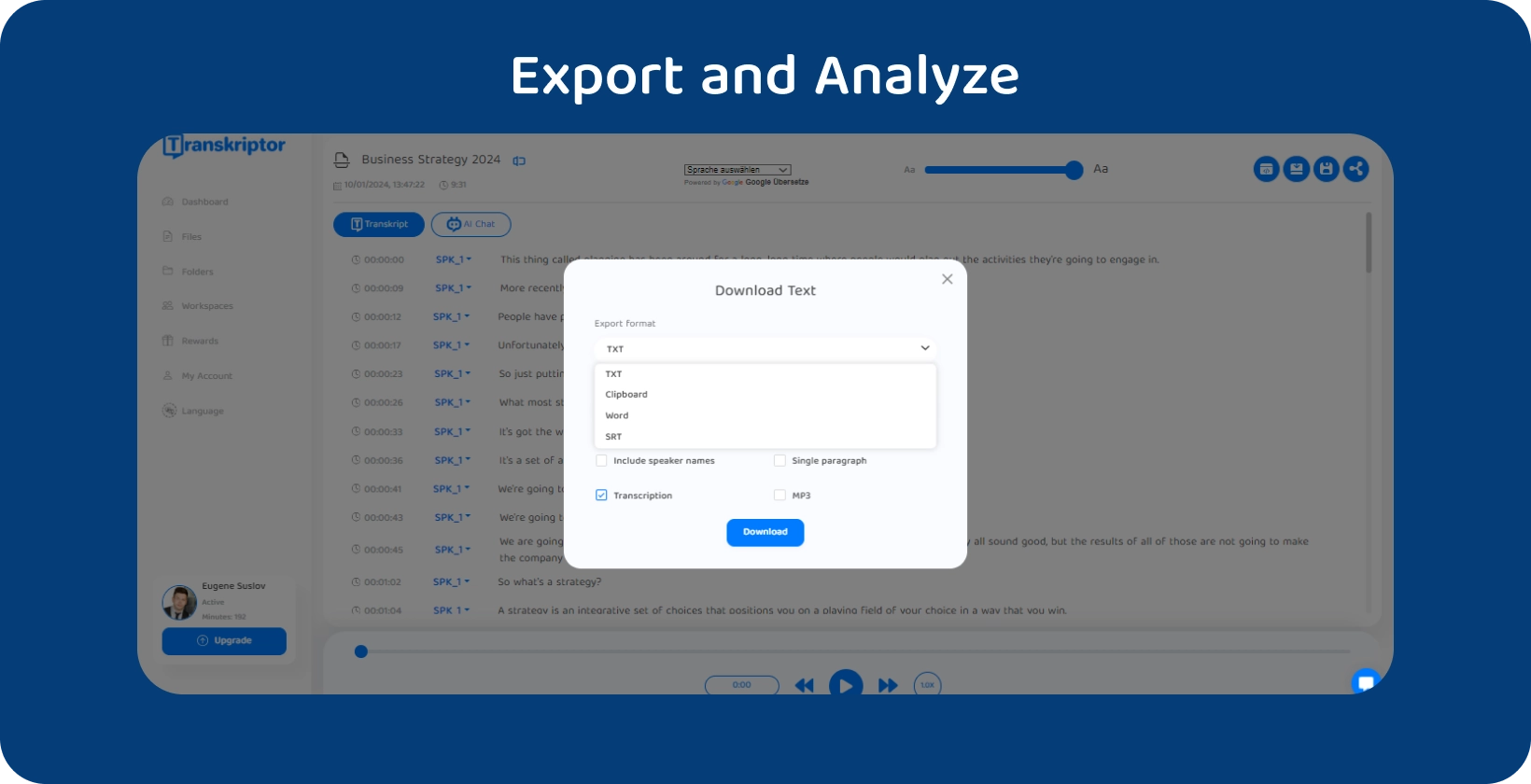Navigating the transcription process involves understanding the best practices for recording interviews , mastering the art of accurate transcription, and utilizing tools like Transkriptor to streamline the process.
The 5 steps of transcribing an interview for qualitative research are listed below.
- Upload to Transkriptor or Record Directly: Choose between uploading pre-recorded files or using Transkriptor's direct recording feature. Use the Meeting Assistant such as Meetingor for multi-speaker sessions.
- Transcribe with AI Precision: Use Transkriptor’s AI-driven services for efficient and accurate transcription, supporting over 100 languages for diverse research needs.
- Review and Edit Transcripts: Systematically check the transcribed text against the audio, and refine readability while maintaining the original speech’s integrity.
- Translate (Optional): Use Transkriptor’s integrated translation services for multilingual research, ensuring accurate representation of the original text.
- Export and Analyze: Download transcripts in various formats suitable for qualitative data analysis, engage deeply with the text to identify themes and insights.
Step 1: Upload to Transkriptor or Record Directly
Users have several options for capturing and submitting their audio files to Transkriptor while transcribing an interview for qualitative research, each tailored to different research needs and contexts.
Upload Files
The Upload feature of Transkriptor allows users to submit pre-recorded audio or video files directly to the platform for transcription. This method is particularly useful for researchers who have conducted interviews outside of Transkriptor and have their recordings ready in digital format.

Transkriptor supports a wide range of file formats, including MP3, MP4, WAV, AAC, M4A , and WEBM, among others, offering flexibility in terms of the type of interview recordings users are able to transcribe.
Users should simply navigate to the Transkriptor dashboard to upload files, select the "Upload" option, and choose the files from their device.
Transkriptor's advanced transcription engine processes the audio once uploaded, converting speech into text with high accuracy.
Direct Recording
The Direct recording feature provides an integrated solution to capture audio directly within Transkriptor for users conducting live interviews or meetings. This option eliminates the need for external recording devices or software, streamlining the transcription process. Transkriptor's mobile apps and web app, providing flexibility for researchers to record using their phones or laptops.

Transcribers initiate a new interview recording session within Transkriptor to use direct recording, ensuring their microphone is configured correctly and tested for optimal audio capture.
The audio is recorded in real-time as the interview proceeds, and upon completion, the recording is immediately available for transcription within the platform.
Meeting Assistant
As a meeting assistant, Meetingtor is a digital platform designed to integrate with your calendar and manage your online meetings. It expands Transkriptor's capabilities to accommodate multi-speaker meetings and interviews, commonly used in platforms like Zoom, Microsoft Teams, and Google Meet . This tool is specifically designed to handle the dynamics of group discussions, capturing each participant's contributions clearly.
Step 2: Transcribe with AI Precision
Transcribing interviews is critical in data analysis, demanding precision and efficiency. Users should harness the power of Transkriptor's AI-driven transcription services to convert their interviews into accurately transcribed text.
This sophisticated AI technology is designed to recognize and accurately transcribe speech from audio recordings, making it an invaluable tool for researchers.
Transkriptor's AI capabilities support over 100 languages, accommodating a wide range of qualitative research projects that span diverse linguistic groups. This feature mainly benefits users conducting international research or working with multilingual participants.
The advantage of using AI for transcription lies in its ability to process large volumes of audio data quickly and with high precision. This efficiency enables researchers to move faster from data collection to analysis, accelerating the overall research timeline.
Users should ensure that their qualitative data is transcribed accurately and ready for analysis, supporting a thorough and insightful research process.
Step 3: Review and Edit Transcripts
The next critical phase in qualitative research involves reviewing and editing transcripts. Users should systematically review the transcribed text , comparing it against the original audio to verify its correctness. This process allows identifying and correcting discrepancies or errors during the AI transcription phase.

The review process also involves refining the readability of the transcripts. While AI transcription provides a high level of accuracy, it doesn’t always capture the nuances of human speech, such as pauses, intonations, and non-verbal cues, which are significant in qualitative research. Users are encouraged to add annotations or notes to the transcripts to capture these subtleties, providing context crucial for data analysis.
Editing transcripts further ensures the text is coherent and follows a logical structure. This includes removing irrelevant sections and repetitive phrases or correcting grammatical errors that do not affect the participant's speech's meaning but improve the transcript's clarity.
Users need to maintain the integrity of the original speech while making these edits, preserving the participant's voice and intent.
Step 4: Translate (Optional)
Translating transcribed interviews enables users to bridge language barriers, making the insights gathered from interviews accessible to a broader audience or research team members who do not speak the original language of the interview.
Transkriptor facilitates this step by offering integrated translation services that support multiple languages, ensuring that translations maintain the nuance and meaning of the original text.
Users must ensure their transcripts are accurately reviewed and edited for clarity and correctness to initiate translation. Transcripts should be submitted for translation through Transkriptor's platform once finalized.
The translation process leverages advanced AI algorithms designed to understand and convert text accurately between languages, preserving the essence of the participants' responses and the researchers' questions.
Step 5: Export and Analyze
The final step in the qualitative research process involves exporting and analyzing the data. Users should utilize Transkriptor's export function to download their transcripts in various formats, such as TXT, Clipboard, Word , or SRT, depending on their analysis needs.

This flexibility ensures that the data is easily imported into qualitative data analysis software (QDAS) or reviewed manually.
Exporting the transcripts marks the transition from data preparation to deep analysis. Users engage with the text to identify themes, patterns, and insights relevant to their research questions.
The analysis process involves reading through the transcripts multiple times, coding the data, and categorizing codes into themes that emerge from the data itself. This in-depth engagement with the text allows researchers to construct a nuanced understanding of the interviewees' perspectives, experiences, and the study context.
The QDAS software facilitates the organization, coding, and thematic analysis of the transcripts. These tools offer features such as text search, coding, and the ability to visualize data connections, enhancing the efficiency and depth of analysis.
The goal remains to distill meaningful insights from the interviews that contribute to the broader research objectives, whether analyzing data manually or using software.
What is Qualitative Research?
Qualitative research is a methodological approach that seeks to understand how people interpret their experiences, the meanings they attribute to those experiences, and the world in which they live. Users of qualitative research methods focus on collecting non-numerical data, typically through interviews, observations, and textual analysis, to gain insights into people's attitudes, behaviors, and interactions.
Users prioritize depth over breadth in qualitative research. They aim to gather detailed information from a smaller sample size rather than seeking to generalize findings across a larger population. This approach allows researchers to explore complex phenomena within specific contexts, offering rich, nuanced understandings that quantitative methods are able to overlook.
Transcribers engage in qualitative research when they wish to explore questions of 'how' and 'why' rather than 'how many' or 'how much.' This method is particularly suited to studies that explore new or poorly understood areas, where the goal is to generate hypotheses and theories
Why is Accurate Transcription Crucial for Qualitative Research?
Accurate transcription is fundamental to the success of qualitative research, serving as the bridge between raw data and insightful analysis. The fidelity of transcribed interviews to the original audio is paramount for users engaged in qualitative studies, as it ensures that the nuances of participants' speech are faithfully represented in text form. This accuracy is critical for several reasons.
First, accurate transcription provides a reliable foundation for analysis. Users depend on the precision of transcripts to perform detailed examinations of the data, identifying themes, patterns, and insights that emerge from participants' responses.
Second, the integrity of the research process hinges on the faithful representation of participants' words. Qualitative research often dives into sensitive topics or personal experiences. Accurate transcription respects the participants' voices, ensuring their perspectives are accurately documented and analyzed.
Moreover, accurate transcription enables users to conduct a thorough and robust analysis. It allows researchers to return to the data multiple times, uncovering deeper meanings and connections that aren’t apparent on initial examination. This iterative analysis process is crucial for comprehensively understanding the research topic.
What Challenges Do Researchers Face in Transcribing Interviews?
Researchers engaged in transcribing interviews for qualitative research encounter several challenges that impact the accuracy and efficiency of the transcription process. These challenges arise from both spoken language's nature and transcription's practical aspects.
Firstly, dealing with poor audio quality is a significant challenge. Background noise, low speaking volumes, and unclear articulation make it difficult for researchers to discern words accurately, leading to potential errors or omissions in the transcript. Users must often replay sections multiple times, which is time-consuming and frustrating.
Secondly, the presence of multiple speakers adds complexity to the transcription process. Distinguishing between speakers, especially when interrupting or speaking simultaneously, requires careful attention and slowing down the transcription process. Researchers must develop strategies to attribute speech to the correct individual accurately.
Moreover, researchers face the challenge of dialects and accents, which vary significantly among participants. Transcribing speech from speakers with unfamiliar accents or regional dialects accurately demands a high level of linguistic competence and requires additional research or consultation.
Finally, the time-consuming nature of transcription is a challenge in itself. Transcription takes several hours for just one hour of audio, placing significant demands on researchers' time and resources. This is particularly challenging for large-scale studies or when researchers work under tight deadlines.
Streamlining Qualitative Research with Transkriptor
In qualitative research, transcribing interviews is essential, offering a textual version of audio or video recordings. This detailed process, crucial for data analysis, involves converting spoken words into written text to capture the depth of participants' responses. Using advanced tools like Transkriptor can significantly ease this task.
Transkriptor stands out by offering fast, accurate transcription in over 100 languages, making it an invaluable tool for researchers dealing with diverse linguistic data. It not only generates subtitles by converting audio to text but also provides options for exporting in various formats, complete with timestamps and speaker names. This functionality is crucial for researchers aiming to overcome common transcription challenges such as poor audio quality, multiple speakers, varied dialects, and the extensive time commitment typically required. Try now!






 Dubai, UAE
Dubai, UAE